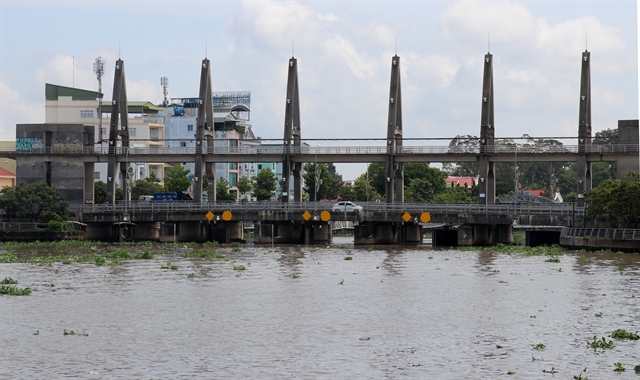 Environment
Environment

 |
| The Kiên River Irrigation System in Rạch Giá City prevents saltwater intrusion, keeps fresh water, and regulates water to serve agricultural production and daily lives of people in the Long Xuyên Quadrangle region in the Mekong Delta province of Kiên Giang. — VNA/VNS Photo Lê Huy Hải |
MEKONG DELTA — Experts said salt water intrusion in the Mekong Delta could intensify in the coming months as the dry season leaves coastal regions exposed.
Heavy rains at the end of September 2023 have not reassured people in the Mekong Delta because the relevant data leads to forecasts of a fierce dry season and a prolonged drought in the near future.
Localities and people in the Mekong Delta are racing to respond to drought and saltwater intrusion in the dry season of 2023-2024, a dry season that is forecast to come early and be severe.
Lê Thanh Hiếu, a farmer in Hậu Giang Province's Long Mỹ District, said that from October to Tết (Lunar New Year), salt water could penetrate deeply into the inland canal, and sometimes the salinity concentration could rise to more than 10‰. Therefore, the government often recommended that people in affected areas sow the winter-spring rice crop early and use salt-tolerant rice varieties.
Hậu Giang Province has about 12,000 hectares of winter-spring rice crop and more than 18,500 hectares of fruit trees that are likely to be affected by saltwater intrusion from sea tides.
In the 2023-2024 Winter-Spring rice crops, the Mekong Delta has sown 1.47 million hectares, with an estimated output of 10.6 million tonnes. The Ministry of Agriculture and Rural Development has assessed that 108,000 hectares of shrimp and rice production in the Cà Mau peninsula are likely to lack clean water. In the case of saltwater intrusion similar to that of the 2015-2016 dry season, about 60,000 hectares of Winter-Spring rice and 43,000 hectares of fruit trees in Long An, Tiền Giang, Bến Tre, Tà Vinh, and Sóc Trăng are at risk of water shortage.
Reports from the Ministry of Agriculture and Rural Development show that flood water in the Mekong River Delta is currently at near the average level of past years.
Tonle Sap in Cambodia, an important source of additional water for the Mekong Delta in the dry season, is now at a level lower than the average of recent years.
Saltwater intrusion this dry season is likely to be higher than average, affecting the operation and collection of water for agricultural production and people's livelihoods.
In order to proactively implement solutions to prevent and combat drought and saltwater intrusion, the ministry has requested the People's Committee of localities in the Mekong Delta to urgently monitor the development of the hydrometeorological forecasts and saline intrusion.
Localities have been asked to develop scenarios and reaction plans to prevent and control drought and saltwater intrusion in line with the current situation in each locality, including plans to cope with extreme saline intrusion as happened in the years of 2015-16 and 2019-20.
Localities need to target areas likely to be affected by saltwater intrusion to direct and deploy appropriate response solutions. These areas would be given priority to get water supplies for people's daily life, livestock farming and crops of high economic value in case of drought or saltwater intrusion.
Localities have also been required to target fruit trees at risk of being affected by saline intrusion, quickly calculate and balance water sources, and strengthen the construction of dispersed water ponds to ensure enough water to maintain the development of trees.
Trần Hoàng Nhật Nam, deputy director of Tiền Giang Department of Agriculture and Rural Development, said that the province had dredged canals and installed pump stations to store freshwater in the canals, actively ensuring water for both daily life and production in the dry season.
In addition, Tiền Giang was urgently completing a saltwater prevention sluice gate on Nguyễn Tấn Thành Canal in Châu Thành District, located 420 metres from Tiền River. The project would prevent salinity and provide domestic water and irrigation for 1.1 million people and 128,000 hectares of production land in Tiền Giang and Long An provinces.
Meanwhile, Lê Hữu Toàn, deputy director of the Department of Agriculture and Rural Development of Kiên Giang Province, said that to ensure clean water for rural areas and island districts, the People's Committee of Kiên Giang Province had directed the department to coordinate with relevant units to control the sewer system in Rạch Giá City and along the Cái Bè River to effectively preserve fresh water and prevent salinity.
In addition, this locality was also accelerating the repair of culverts, installation of valves for 17 coastal sluices, and bconstruction of dams to prevent salinity to ensure agricultural production.
In other provinces and cities in the Mekong Delta, they are urgently dredging canals, digging ponds and wells and building temporary dams to store fresh water for emergency situations. Ongoing construction of irrigation works and works to keep water fresh, control salinity, canal systems, and water pipelines in high-risk areas must be completed as soon as possible.
Localities will be in charge of monitoring saline intrusion in at-risk areas and promptly informing the communities. — VNS